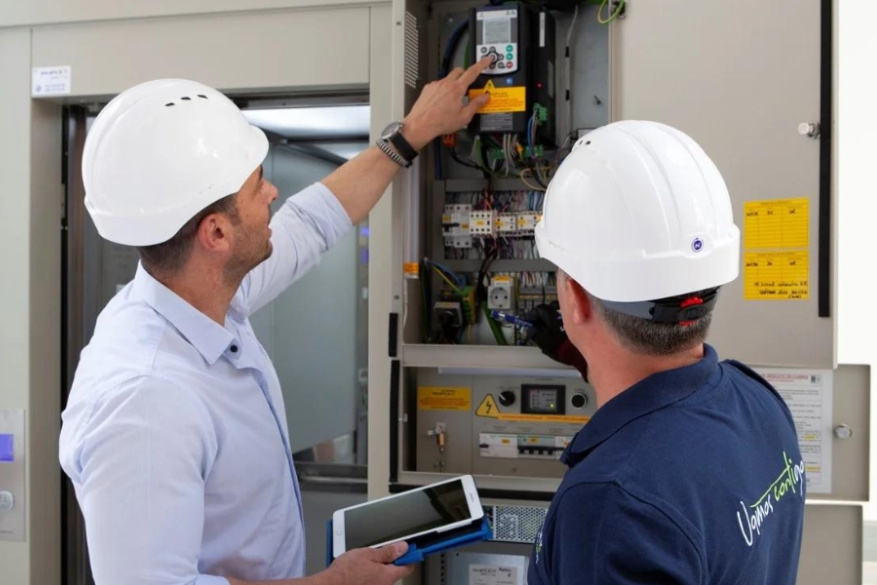- L’entreprise
- Nos Produits
- Accès clients
- Nouvelles
- Contacts
- Ecommerce
- Ventes & marketing:
+34 954 514 500
sales@hidral.com
This website uses its own and third-party cookies to improve our services and collect information about your browsing. If you click "accept" or continue browsing, we will consider that you accept the use and installation of your device or device. You will find more information in our Politique cookies.
16/06/23

Lift safety is a fundamental aspect that must be taken into account in all buildings and places where these vertical transport systems are used. Lifts play a crucial role in our daily lives, facilitating access to different levels of a building and saving time and effort. In this article, we will explore the importance of lift safety, highlighting potential hazards in lifts. As well as key features and technologies to ensure the safety of their users.
Of the potential hazards that can compromise safety in lifts, we find that most of them are avoidable. The design and manufacture of lifts is the most important part of the process to avoid potential accidents, in addition to correct installation and subsequent maintenance.
1. Locking doors: If the lift doors are locked or do not close properly, there may be a risk of incidents, such as people getting trapped between the doors or objects preventing the doors from closing.
2. Sudden stops: Abrupt or sudden stops of the lift can cause bumps or falls inside the car, endangering the safety of passengers.
3. Mechanical problems: Mechanical problems such as failure of the braking system, failure of suspension ropes or failure of essential components can lead to dangerous situations such as free falls or lift breakdowns.
4. Fire: In the event of a fire in a building, the lift can become a potential trap if proper safety measures are not implemented. Smoke and heat can penetrate the car, making evacuation difficult or even impossible.
5. Overweight: If the maximum weight capacity of the lift is exceeded, safety is compromised by overloading components and reducing the stability of the lift.
6.Electrical faults: Power outages or electrical failures can cause the lift to stop, leaving passengers trapped inside, sometimes in the dark, which can lead to anxiety and emergency situations.
7.Lack of maintenance: Inadequate or neglected maintenance can lead to system failures, wear and tear of parts and increased safety risks. Lack of regular maintenance can also delay problem detection and resolution.
It is essential to implement adequate safety measures to prevent these hazards and ensure safety in lifts.
Safety in lifts is essential to ensure the protection and well-being of the people who use them. There are several key features and technologies that contribute to maintaining a safe lift environment.
1. Emergency braking system
Modern lifts are equipped with an emergency braking system that acts in the event of a failure in the main system. This mechanism stops the lift safely in the event of an unexpected situation, such as a free fall or a failure of the suspension ropes.
2. Safety doors and sensors
Lift doors are designed with automatic closing mechanisms and safety sensors. These sensors detect the presence of objects or people in the doors and prevent the doors from closing if there is an obstacle, reducing the risk of entrapment or injury.
3. Communication system
Lifts should be equipped with a communication system, such as an intercom or emergency telephone, which allows passengers to call for help in the event of an emergency or breakdown. This ensures a quick and efficient response to any problematic situation.
4. Regular maintenance
Lift safety also depends to a large extent on regular maintenance. Specialised technicians must carry out regular inspections, check key components and ensure that the entire system is working properly. This helps prevent potential failures and ensures optimum performance.
5. Technological upgrading
Technology continues to advance, and lifts are no exception. The latest innovations include intelligent control systems, remote monitoring and high-precision sensors. These technologies improve safety by providing more precise control and detecting potential problems before they become real risks.
Lift safety is an issue of vital importance that should not be underestimated. Safe lifts ensure the comfort, efficiency and, most importantly, the physical integrity of the people who use them. The key features and technologies mentioned in this article are just a few examples of how this crucial aspect is addressed in the lift industry. It is the responsibility of designers, manufacturers and building owners to ensure that lifts meet the highest safety standards for the benefit and peace of mind of all.
Hidral, at the forefront of lift safety, designs and manufactures lifts and elevators for professional supply. By choosing Hidral as a lift supplier, professionals and building owners can have peace of mind that they are purchasing equipment that meets the highest standards in terms of safety. Hidral's experience and reputation in the industry is a guarantee of reliable service and quality products.